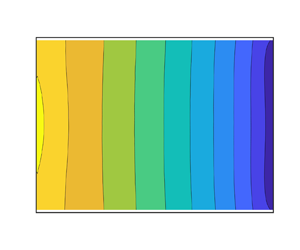No CrossRef data available.
Published online by Cambridge University Press: 30 September 2024

The plane Poiseuille flow of a rarefied gas in a finite length channel, driven by an axial pressure gradient, is analysed numerically to probe (i) the role of ‘dilatation’ ( $\varDelta ={\boldsymbol \nabla }\boldsymbol {\cdot }{\boldsymbol u}\neq 0$) on its thermohydrodynamics as well as to clarify (ii) the possible equivalence with its well-studied ‘dilatation-free’ or ‘isochoric’ (
$\varDelta ={\boldsymbol \nabla }\boldsymbol {\cdot }{\boldsymbol u}\neq 0$) on its thermohydrodynamics as well as to clarify (ii) the possible equivalence with its well-studied ‘dilatation-free’ or ‘isochoric’ ( ${\rm D}\rho /{\rm D}t=0$) counterpart driven by a constant acceleration. Focussing on the mass flow rate
${\rm D}\rho /{\rm D}t=0$) counterpart driven by a constant acceleration. Focussing on the mass flow rate  ${\mathcal {M}}({Kn})$, which is an invariant quantity for both pressure-driven and acceleration-driven Poiseuille flows, it is shown that while
${\mathcal {M}}({Kn})$, which is an invariant quantity for both pressure-driven and acceleration-driven Poiseuille flows, it is shown that while  ${\mathcal {M}}\sim \log {{Kn}}$ at
${\mathcal {M}}\sim \log {{Kn}}$ at  ${Kn}\gg 1$ in the acceleration-driven case, the mass flow saturates to a constant value
${Kn}\gg 1$ in the acceleration-driven case, the mass flow saturates to a constant value  ${\mathcal {M}}\sim {{Kn}}^0$ at
${\mathcal {M}}\sim {{Kn}}^0$ at  ${Kn}\gg 1$ in the pressure-driven case due to the finite length (
${Kn}\gg 1$ in the pressure-driven case due to the finite length ( $L_x<\infty$) of the channel. The latter result agrees with prior theory and recent experiments, and holds irrespective of the magnitude of the axial pressure gradient (
$L_x<\infty$) of the channel. The latter result agrees with prior theory and recent experiments, and holds irrespective of the magnitude of the axial pressure gradient ( $G_p$). The pressure-dilatation cooling (
$G_p$). The pressure-dilatation cooling ( $\varPhi _p=-p\varDelta <0$) is shown to be responsible for the absence of the bimodal shape of the temperature profile in the pressure-driven Poiseuille flow. The dilatation-driven reduction of the shear viscosity and the odd signs of two normal stress differences (
$\varPhi _p=-p\varDelta <0$) is shown to be responsible for the absence of the bimodal shape of the temperature profile in the pressure-driven Poiseuille flow. The dilatation-driven reduction of the shear viscosity and the odd signs of two normal stress differences ( ${\mathcal {N}}_1$ and
${\mathcal {N}}_1$ and  ${\mathcal {N}}_2$) in the pressure-driven flow in comparison with those in its acceleration-driven counterpart are explained from the Burnett-order constitutive relations for the stress tensor. While both
${\mathcal {N}}_2$) in the pressure-driven flow in comparison with those in its acceleration-driven counterpart are explained from the Burnett-order constitutive relations for the stress tensor. While both  ${\mathcal {N}}_1$ and
${\mathcal {N}}_1$ and  ${\mathcal {N}}_2$ appear at the Burnett order
${\mathcal {N}}_2$ appear at the Burnett order  $O({{Kn}}^2)$ in the acceleration-driven flow, the leading term in
$O({{Kn}}^2)$ in the acceleration-driven flow, the leading term in  ${\mathcal N}_1$ scales as
${\mathcal N}_1$ scales as  $(\mu/p)\varDelta$ due to the non-zero dilatation in the pressure-driven Poiseuille flow which confirms that the two flows are not equivalent even at the Navier–Stokes–Fourier order
$(\mu/p)\varDelta$ due to the non-zero dilatation in the pressure-driven Poiseuille flow which confirms that the two flows are not equivalent even at the Navier–Stokes–Fourier order  $O({{Kn}})$. The heat-flow rate (
$O({{Kn}})$. The heat-flow rate ( ${{\mathcal {Q}}_q}_x=\int q_x(x,y) \,{{\rm d} y}$) of the tangential heat flux is found to be negative (i.e. directed against the axial pressure gradient), in contrast to its positive asymptotic value (at
${{\mathcal {Q}}_q}_x=\int q_x(x,y) \,{{\rm d} y}$) of the tangential heat flux is found to be negative (i.e. directed against the axial pressure gradient), in contrast to its positive asymptotic value (at  ${Kn}\gg 1$) in the acceleration-driven flow. Similar to the scale-dependence of the mass flow rate,
${Kn}\gg 1$) in the acceleration-driven flow. Similar to the scale-dependence of the mass flow rate,  ${{\mathcal {Q}}_q}_x({{Kn}}, L_x)$ is found to saturate to a constant value at
${{\mathcal {Q}}_q}_x({{Kn}}, L_x)$ is found to saturate to a constant value at  ${Kn}\gg 1$ in finite length channels. The double-well shape of the
${Kn}\gg 1$ in finite length channels. The double-well shape of the  $q_x(y)$-profile in the near-continuum limit agrees well with predictions from a generalized Fourier law. On the whole, the dilatation-driven signatures (such as the pressure-dilatation work and the ‘normal’ shear-rate differences) are shown to be the progenitor for the observed differences between the two flows with regard to (i) the hydrodynamic fields, (ii) the rheology and (iii) the flow-induced heat transfer.
$q_x(y)$-profile in the near-continuum limit agrees well with predictions from a generalized Fourier law. On the whole, the dilatation-driven signatures (such as the pressure-dilatation work and the ‘normal’ shear-rate differences) are shown to be the progenitor for the observed differences between the two flows with regard to (i) the hydrodynamic fields, (ii) the rheology and (iii) the flow-induced heat transfer.